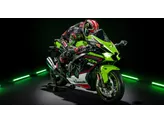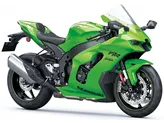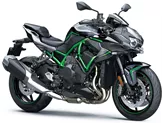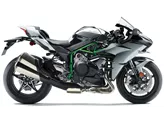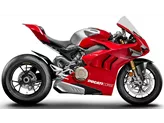Kawasaki Z H2 2020 vs. Kawasaki Ninja ZX-10R 2021

Kawasaki Z H2 2020

Kawasaki Ninja ZX-10R 2021
Overview - Kawasaki Z H2 2020 vs Kawasaki Ninja ZX-10R 2021
The Kawasaki Z H2 2020 and the Kawasaki Ninja ZX-10R 2021 are both powerful motorcycles with impressive technical specifications. However, they have some key differences that set them apart.
Starting with the engines, both bikes have an inline-four configuration with the same bore and stroke measurements. However, the Z H2 has an engine power of 200 HP, while the Ninja ZX-10R boasts a slightly higher power output of 203 HP. The Z H2 also has higher torque at 137 Nm compared to the Ninja ZX-10R's 114.9 Nm. The compression ratio of the Z H2 is 11.2, while the Ninja ZX-10R has a higher compression ratio of 13.
In terms of suspension, both bikes feature upside-down telescopic forks at the front and a swing arm with a monoshock at the rear. The Z H2's suspension is adjustable for compression, preload, and rebound, as is the Ninja ZX-10R's. The rear shock absorber of the Z H2 is made of aluminum, while the Ninja ZX-10R's frame is also made of aluminum.

Kawasaki Z H2 2020
When it comes to braking, both bikes have double disc brakes at the front with four-piston calipers. The Z H2's front brakes have a diameter of 320 mm, while the Ninja ZX-10R's front brakes have a larger diameter of 330 mm. Both bikes use Brembo brakes, but the Ninja ZX-10R has a petal technology for its front brakes, which may provide better heat dissipation.
In terms of dimensions and weights, both bikes have the same front and rear tire widths and diameters. The Z H2 has a slightly longer wheelbase at 1455 mm compared to the Ninja ZX-10R's 1440 mm. The seat height of the Z H2 is 830 mm, while the Ninja ZX-10R has a slightly higher seat height of 835 mm. The Z H2 also has a larger fuel tank capacity of 19 liters, while the Ninja ZX-10R has a smaller capacity of 17 liters.

Kawasaki Ninja ZX-10R 2021
Now, let's discuss the strengths and weaknesses of each bike. The Z H2's strengths lie in its incomparable engine power, easy-to-control power unit, pleasant seating position, high riding comfort for a naked bike, stable handling, and quiet but charismatic sound. It is also a motorbike that can be ridden carefree in everyday life. However, it has some weaknesses, including a quickshifter that makes interventions that take too long, a suspension strut that becomes spongy during sporty riding, and a lack of exclusive components considering its exclusive status.
On the other hand, the Ninja ZX-10R's strengths include high-quality workmanship, strong components, a high-revving and powerful engine, great wind protection with good aerodynamics, a good seating position even for tall riders, a high-quality electronics package, powerful brakes, and a well-balanced chassis. However, it has some weaknesses, such as load change reactions in the partial load range, a somewhat slow quickshifter, and a relatively small display.
In conclusion, the Kawasaki Z H2 2020 and the Kawasaki Ninja ZX-10R 2021 are both impressive motorcycles with their own strengths and weaknesses. The Z H2 excels in terms of engine power and everyday rideability, while the Ninja ZX-10R offers high-quality components and a well-balanced performance. Ultimately, the choice between the two will depend on the rider's preferences and priorities.
Technical Specifications Kawasaki Z H2 2020 compared to Kawasaki Ninja ZX-10R 2021
Pros and Cons in comparison
Pros and Cons in comparison
Kawasaki Z H2 2020

The fascinating power unit of the Kawasaki not only inspires as a motif for quartet cards or at the regulars' table. The engine is made for practical use. In the saddle of the bike, you can enjoy the thrust in every situation. Commands from the throttle are implemented directly, intensively but also controllably. However, the bike is not an athletic sportsman but a beefy naked bike. It always scores when sovereignty and power are required.
Kawasaki Ninja ZX-10R 2021

Kawasaki offers a mature overall package with the Ninja ZX-10R in the 2021 model year, which with the new front end also really looks like 2021. The bike offers surprisingly good space for the rider and you feel comfortable in the saddle. The rev-happy engine leaves nothing to be desired - except perhaps more discipline in the part-load range. To make the project a success, Kawasaki relies on high-quality ingredients: Showa suspension, Öhlins steering dampers, Brembo brakes with 330 discs and high-quality electronics. Thanks to the good electronics and the superior engine, the Ninja ZX-10R even cuts quite a figure on country roads - as long as you are willing to suffer a little in terms of seating position due to the concept.
Price Comparison Avarage Market Price Kawasaki Z H2 vs Kawasaki Ninja ZX-10R
There are a few key differences between a Kawasaki Z H2 2020 and a Kawasaki Ninja ZX-10R 2021. There are the same number of bikes of both models available on the 1000PS.de marketplace, specifically 10. It takes less time to sell a Kawasaki Z H2 with 148 days compared to 177 days for a Kawasaki Ninja ZX-10R. Since model year 2020 1000PS.de editors have written 14 reviews for the Kawasaki Z H2 and 51 reviews for the Kawasaki Ninja ZX-10R since model year 2005. The first review for the Kawasaki Z H2 was published on 10/10/2019 and now has more than 82,500 views. This compares to more than 2,900 views for the first review on Kawasaki Ninja ZX-10R published on 11/01/2004.


